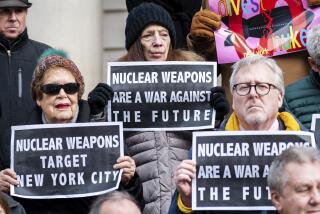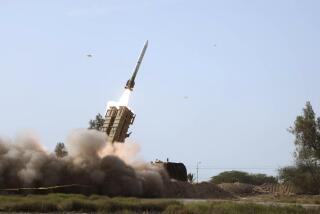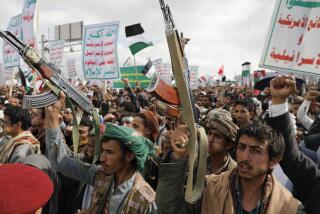Pentagon Shifts on Missile Shield
- Share via
WASHINGTON — Pentagon officials, in a major shift, said Wednesday that they now believe the threat of a missile attack from a rogue nation warrants construction of a controversial national missile shield.
After years of deliberation, top defense officials said that they plan to deploy a system that would blow up an incoming missile with another, provided they can overcome technical problems that have plagued their long research effort.
In light of those stubborn technical hurdles, however, they announced that they are delaying the target date of deployment from 2003 to 2005.
“We affirm that there is a threat and the threat is growing. And it will pose a danger not only to our troops but also to Americans here at home,” said Defense Secretary William S. Cohen, who has asked for $6.6 billion for deployment of the system in the department’s long-term, six-year budget.
Beginning with President Reagan’s ambitious “Star Wars” program of the 1980s, missile defense programs have cost $40 billion without successfully demonstrating that a missile can track and destroy an incoming missile. The Clinton administration has continued planning and research on the effort without making binding commitments.
Yet the program has gained increasing political momentum since August, when North Korea test-fired an advanced three-stage Taepo Dong 1 missile. North Korea is believed to be at work on a successor missile with a 3,600-mile range, sufficient to reach Alaska and Hawaii.
The Iranians have tested an intermediate-range Shahab 3 missile and may also be only several years away from an intercontinental weapon. U.S. officials also fear the Iraqis’ ambitions, as well as those of the nearly two dozen other nations that are believed to be trying to develop missile programs.
Long-range missiles capable of hitting the United States from some of these nations could be ready within as little as two years, officials said.
The administration’s declaration has a special meaning for Southern California, since many of the companies that have been working on the $1-billion-a-year research effort are clustered around Los Angeles International Airport.
With their announcement, Pentagon officials basically embraced the findings of a study panel headed by former Defense Secretary Donald H. Rumsfeld. Last July, the panel concluded that U.S. intelligence agencies had until then underestimated the progress of foreign ballistic missile programs. The panel warned that adversaries could be prepared to hit the United States within a couple of years, with little or no advance sign that they had perfected their technology.
Administration officials have been saying that they would deploy a national missile defense shield if they became convinced that the threat was real and if they could find a way to finance the program, revise their arms-control treaty obligations and overcome the technical challenges of the system. Their plan has been called the “three-plus-three” program because they anticipated in 1997 that they would spend three years assessing the program, then decide in mid-2000 whether to deploy it three years later.
Air Force Gen. Lester Lyles, the Pentagon’s top missile defense official, said: “As announced by Secretary Cohen, we’ve acknowledged that the threat is real and growing in the near future.” He added: “That, essentially, leaves one major thing. Are we technologically ready to deploy such a system?”
The timetable calls for the Pentagon to decide in June 2000 whether it will deploy the system, even though tests on some key components will not be completed for three more years.
In hopes of hastening the technical work, officials announced the reorganization of a related program to build a smaller-scale “theater missile” defense program, aimed at protecting troops and equipment in the field from short- and intermediate-range ballistic missiles.
The Pentagon’s attention has been focused primarily on the Army’s Theater High Altitude Defense program. But THAAD has been crippled by five test flight failures, which have been blamed on the poor quality of missile parts and systems integration work.
Officials announced that they are adding about $500 million to the funding of a rival Navy system, called Navy Theater Wide Defense. The two programs are now basically competitors. Pentagon officials will decide late next year.
The national missile defense program is not intended to knock down the hundreds of missiles that might have been sent by the Soviet Union but only the few that could be sent by a rogue nation or launched accidentally.
Among the components of the system are space sensors orbiting the Earth on satellites to identify the launch of hostile missiles and ground-based radar stations to distinguish threatening from nonthreatening craft. The defensive missile, or interceptor, would be fired from the ground and mounted with a hit-to-kill vehicle that would maneuver in space to track and destroy the enemy warhead before it could reach the ground.
An obstacle to the development of any national missile defense system has been the Anti-Ballistic Missile Treaty with Russia. The treaty limits the United States and Russia from deploying anti-missile defenses at more than one site.
Administration officials said Clinton wrote to Russian President Boris N. Yeltsin in advance of Cohen’s comments to assure the Russians that the announcement does not represent a commitment to deploy any anti-missile system and does not represent a change in the U.S. commitment to the ABM treaty, a senior official said.
The administration’s greater interest in national missile defense may help it outflank Republicans in Congress, who have sought to make an issue of the administration’s ambivalence in the past.
Republicans have sought repeatedly to add money to the missile defense budget. Sen. Thad Cochran (R-Miss.) said he was “excited” by the administration’s new view of missile defense after meeting Wednesday with Cohen.
Some foes of missile defense lamented the day’s developments.
Tom Collina, who directs the arms control program for the Union of Concerned Scientists, said that any adversary could easily get around the missile defense shield by sending decoys in missiles or using terrorists to deliver bombs.
“It’s just very easy for enemies to respond,” he said.
* EFFECT UNCERTAIN: It’s unclear whether California would benefit from the missile-defense proposal. C1
More to Read
Sign up for Essential California
The most important California stories and recommendations in your inbox every morning.
You may occasionally receive promotional content from the Los Angeles Times.











